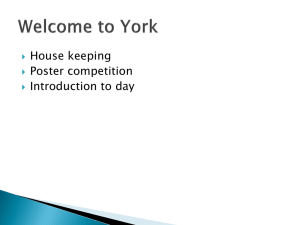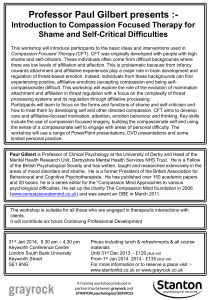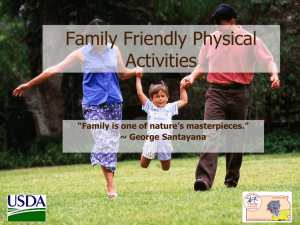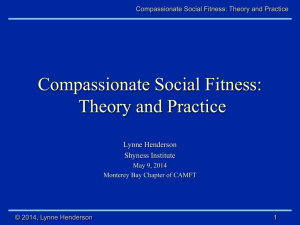Compassionate Social Fitness
advertisement
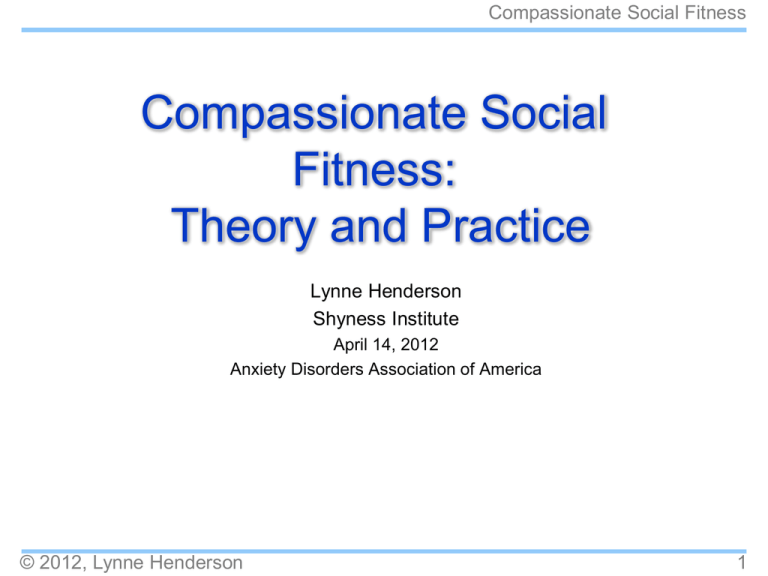
Compassionate Social Fitness Compassionate Social Fitness: Theory and Practice Lynne Henderson Shyness Institute April 14, 2012 Anxiety Disorders Association of America © 2012, Lynne Henderson 1 Compassionate Social Fitness Overview Social Fitness Training: Theory and Practice Stanford/Palo Alto shyness clinic Compassion Focused Therapy Adding a compassion focus For better self-soothing For shame vulnerable clients For therapists who do individual Social Fitness Training Compassionate Social Fitness Training The case of Jane BUT! Be prepared………………………………………………. © 2012, Lynne Henderson 2 Compassionate Social Fitness Three Vicious Cycles Fear Shame Anger Negative predictions Self-blame Other-blame Approach Avoidance Resentment © 2012, Lynne Henderson 3 Compassionate Social Fitness What is Social © Fitness ? Social Fitness, like physical fitness, is a state of physiological, behavioral, emotional, and mental conditioning that implies adaptive functioning and a sense of well being. © 2012, Lynne Henderson 4 Compassionate Social Fitness Social Fitness Training© © 2012, Lynne Henderson 5 Compassionate Social Fitness Three Virtuous Cycles Face fear Accept self Accept others Accept fear Support self Support others Act through emotion Acceptance © 2012, Lynne Henderson Accept Efforts Accept others’ efforts Support Forgiveness 6 Compassionate Social Fitness Compassion Focused Therapy: Gilbert In order for us to be reassured by a thought (say) ‘I am lovable’ this thought needs to link with the emotional experience of ‘being lovable’. If the positive affect system for such linkage is not activated there is little feeling to the thought. Compassion focused therapy therefore targets the activation of the soothing system © 2012, Lynne Henderson (with permission, Paul Gilbert) 7 Compassionate Social Fitness Types of Affect Regulator Systems Content, safe, connected Drive, excite, vitality Incentive/resourc e- focused Wanting,pursuing, achieving Activating Threat-focused Non-wanting/ Affiliative focused Safeness-kindness Soothing Protection and Safety-seeking Activating/inhibiting Anger, anxiety, disgust © 2012, Lynne Henderson (with permission, Paul Gilbert) 8 Compassionate Social Fitness Basic Philosophy:CFT We all just find ourselves here with a brain, emotions and sense of (socially made) self we did not choose but have to figure out. Life involves dealing with tragedies (threats, losses, diseases, decay, death) and people do the best they can. Much of what goes on in our minds is not of ‘our design’ and not our fault. We are all in the same boat De-pathologising and de-labelling – understanding unique coping processes © 2012, Lynne Henderson (with permission, Paul Gilbert) 9 Compassionate Social Fitness The Need for Compassion in Social Fitness Training For better self-soothing and emotion regulation For shame vulnerable clients For working with individual clients who lack group support To add direct interventions to build compassion for the self and others, to help clients view shyness and shame not as pathology, but as part of human condition To add to Mindfulness work (MBSR) – Jon Kabat-Zinn Henderson, L. (2011). Building social confidence using compassionfocused therapy to overcome shyness and social anxiety. Oakland, CA: New Harbinger Publications, Inc. © 2012, Lynne Henderson 10 Compassionate Social Fitness Three Compassionate Cycles Face fear Accept self Accept others Accept fear Support self Support others Act through emotion Self-compassion Compassion toward others Acceptance Compassion Forgiveness © 2012, Lynne Henderson 11 Compassionate Social Fitness Jane Bright, attractive young woman in mid-twenties, college graduate, living with parents Severe APD, socially isolated, TV four hours per day, works at home, attends community college Shy in elementary school, SAD in middle school © 2012, Lynne Henderson 12 Compassionate Social Fitness Caring-Compassionate Mind SKILLS -TRAINING Warmth Warmth Imagery Attention ATTRIBUTES Care for well-being Feeling Sympathy Sensitivity Compassio n Non-Judgement Reasoning Distress tolerance Empathy Behaviour Sensory Warmth © 2012, Lynne Henderson (with permission, Paul Gilbert) Warmth 13 Compassionate Compassionate Social Social Fitness Fitness Behavior and cognition: In session exposures with challenging and modifying unhelpful thoughts; behavioral homework, non-verbal communication (SOFTEN; Gabor, 2001) Mindfulness: Body scan, breath meditation, Sensory: Building sensory awareness, locating emotions in body Distress tolerance: Expressing emotions, tolerating discomfort (SUDS 70+) Attention: Deliberate focusing of attention Imagery: Safe place, perfect nurturer, compassionate ideal self © 2012, Lynne Henderson 14 Compassionate Social Fitness Doing Better; Feeling Worse ShyQ. EOS 1-5 1-7 M = 4.3 M = 5.4 M = 3.5 M = 3.6 Most Difficult: Giving Talk SAQ-Self-blame 1–9 SAQ-Shame 0–4 Pre M = 9.0 M = 3.2 Post M = 9.0 M = 3.2 Second most difficult: Conversation with one person SAQ-Self-blame 1 – 9 M = 9.0 M = 5.0 SAQ-Shame 0 – 4 M = 2.4 M = 3.0 Third most difficult: Asking a question in class SAQ-Self-blame 1 – 9 M = 9.0 M = 5.0 SAQ-Shame 0 – 4 M = 2.4 M = 3.0 © 2012, Lynne Henderson 15 Compassionate Social Fitness Resistance: Fear of Compassion Remember: Compassion focused therapy targets the activation of the soothing system (to gain positive affect) to connect thoughts with the emotional experience referred to by those thoughts. Compassion can be threatening. Clients can be afraid of compassion toward the self, from others and for others. Gilbert, P., McEwen, K., Matos, M., & Rivis, A. (2011). Fears of compassion: Development of three self-report measures. Psychology and Psychotherapy: Theory, Research and Practice 84, 239-255. © 2012, Lynne Henderson 16 Compassionate Social Fitness Jane: Fear of Compassion/Self Expressing kindness, compassion toward self (rated 4; 0-4) If I really think about being kind and gentle with myself it makes me sad. I fear that if I start to feel compassion and warmth for myself, I will feel overcome with a sense of loss/grief. I fear that if I become too compassionate to myself I will lose my self-criticism and my flaws will show. © 2012, Lynne Henderson 17 Compassionate Social Fitness Jane: Fear of Compassion/Others Responding to compassion from others (rated 4; 0-4) I’m fearful of becoming dependent because they might not always be available or willing to give it. If people are friendly and kind I worry they will find out something bad about me that will change their mind. When people are kind and compassionate towards me I feel empty and sad. © 2012, Lynne Henderson 18 Compassionate Social Fitness © 2012, Lynne Henderson (with permission, Paul Gilbert) 19 Compassionate Social Fitness © 2012, Lynne Henderson (with permission, Paul Gilbert) 20 Compassionate Social Fitness © 2012, Lynne Henderson (with permission, Paul Gilbert) 21 Compassionate Social Fitness © 2012, Lynne Henderson (with permission, Paul Gilbert) 22 Compassionate Social Fitness Countering Resistance to Compassion Acknowledging strengths: Empathy toward her dog, the abandoned student, neighbor, her parents (compassionate sacrifice?) Continuing to build empathy toward her own distress: Continuing to normalize shame, encourage self-disclosure, active listening, reflecting emotions, writing exercises (Kristen Neff) Two chair exercises: Protective self and the hopeful, trusting self Self critical self and compassionate self-correcting self Critical self and empathic self (to her own and others’ distress) © 2012, Lynne Henderson 23 Compassionate Social Fitness © 2012, Lynne Henderson (with permission, Paul Gilbert) 24 Compassionate Social Fitness Three Compassionate Cycles Face fear Accept self Accept others Accept fear Support self Support others Act through emotion Self-compassion Compassion toward others Acceptance Compassion Forgiveness © 2012, Lynne Henderson 25 Compassionate Social Fitness Disclaimer and Information I have no affiliation with any pharmaceutical company and none of my work has ever been supported by an outside commercial enterprise. Director, Shyness Institute 644 Cragmont Ave., Berkeley, CA 94708 Cell: (650) 814-9210 Director, Applied Research Heroic Imagination Project © 2012, Lynne Henderson 220 Halleck Street San Francisco, CA 94129 26
